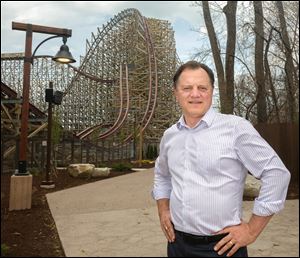
Cedar Fair aims to boost revenue through seasonal events
10/4/2018Cedar Fair LP has a plan to increase its revenue by about 4 percent annually and that plan involves a greater emphasis on seasonal events at its amusement parks like HalloWeekends, which it introduced 21 years ago, or its newer WinterFest event that began in 2016 at a California park and is now at seven of the Sandusky-based company’s 11 amusement venues.

Cedar Fair LP CEO Richard Zimmerman.
Immersive events like HalloWeekends taps into consumer desire for experiences instead of possessions, Richard Zimmerman, Cedar Fair’s CEO, said Thursday during the company’s presentation at the annual B. Riley FBR Consumer & Media Conference in New York. The event, sponsored by a Los Angeles-based investment bank, was for Wall Street analysts and investors.
Mr. Zimmerman said Halloween events take place elsewhere, but “when we put on events like HalloWeekends, we do them immersive, do them to scale, to a level that no one else can do. It really starts to spike demand,” he said.
It also drives a sense of urgency on the part of the consumer. “When we can put in an event ... on top of the value of a visit to the park anyway, with everything else we offer, the rides, the attractions, the entertainment, we see that really driving urgency,” Mr. Zimmerman said.
The company now has events in the third and fourth quarters. The key will be to add them in the all-important second quarter when most of its parks open for the season, the CEO said. “Increasingly, we're looking for events which combine with our [new attractions] lineup to drive more urgency during the year,” he added.
Cedar Fair frequently faces challenges, such as weather issues and competition from other entertainment choices, but of late has faced wage pressures.
Recently, Amazon said it was raising wages for its employees to $15 an hour.
“We’re seeing pressure this year, no doubt, an 8 to 9 percent wage rate pressure this year, which we expected,” Mr. Zimmerman said.
Some wage hikes were mandated by the state of California, where it has two parks, and the Canadian government, which affected its park in Toronto.
“We’ve been able to take the impact out by managing hours and becoming more efficient, look for ways to retool our business model,” Mr. Zimmerman said.
But Cedar Fair, which employs up to 50,000 seasonal employees, expects to face more wage pressure.
“When we’ve seen a little bit of wage pressure, usually that translates into us having more pricing power,” Mr. Zimmerman said, referring to ticket prices. The CEO said that over time, the company has usually been able to offset wage increases by additional price increases.
“I wouldn’t say we could go grab all of that 8 or 9 percent. But our philosophy on pricing has always been to price into demand, and also pass along consistent price increases over time,” he said.
A new trend in attractions is the use of virtual reality with rides, but Mr. Zimmerman said the company has tried that and found it wanting.
“We did put it on two different coasters. Operationally, it was very cumbersome,” the CEO said. Worse, it didn’t attract additional consumer demographic groups and it required more employees.
So rather than continue with virtual reality, Mr. Zimmerman said Cedar Fair plans to experiment more with augmented reality — adding digital elements to a live setting. An example would be the popular Pokemon Go game where virtual characters are seen while looking through a phone.
“Augmented reality has a much lower cost point,” the CEO said. “We will play with that more than with virtual reality at this point.”
Contact Blade Business Writer Jon Chavez at jchavez@theblade.com or 419-724-6128.